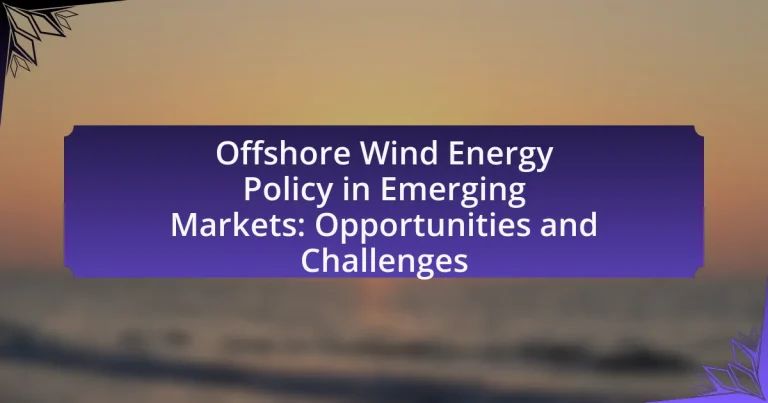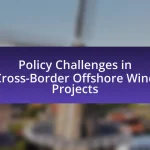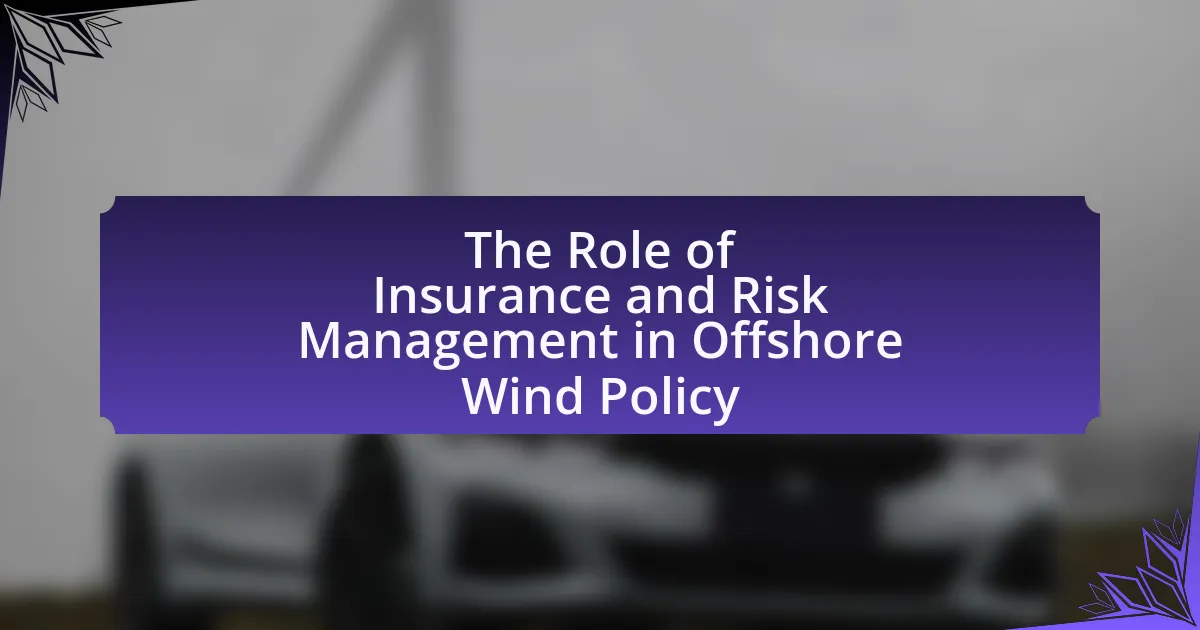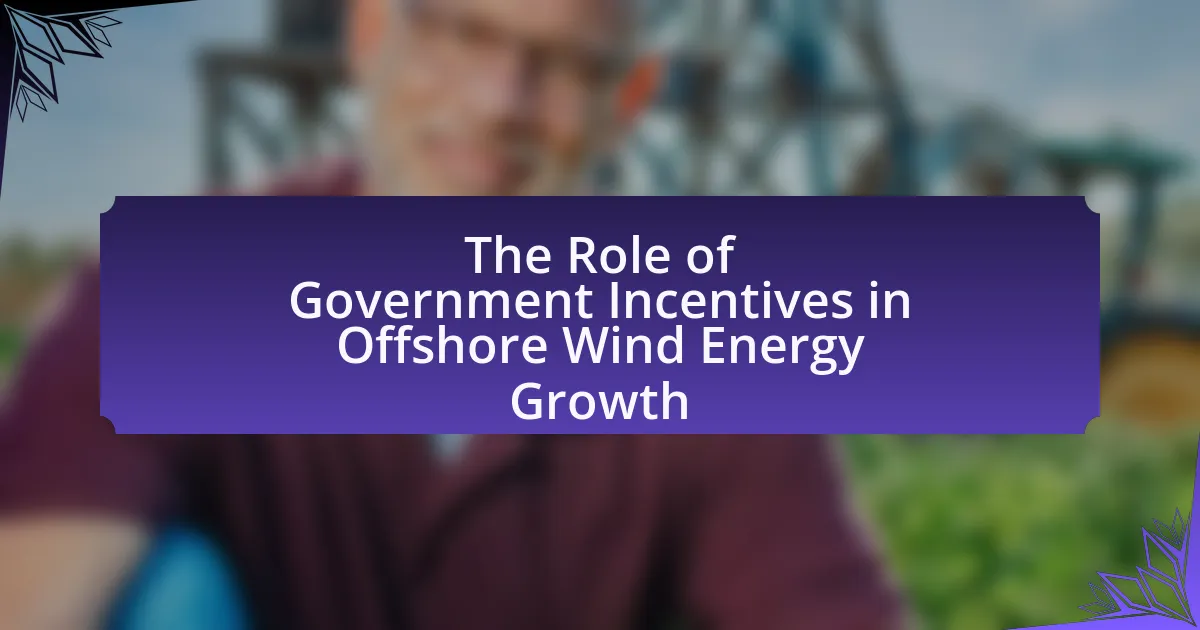Offshore wind energy policy in emerging markets encompasses the regulatory frameworks and strategic initiatives that governments implement to foster the development of offshore wind projects. This article examines the differences between policies in emerging and developed countries, highlighting key components such as financial incentives, regulatory structures, and stakeholder engagement. It also addresses the main objectives of these policies, including enhancing energy security and promoting sustainable development, while identifying challenges such as financial constraints and technological barriers. Furthermore, the article explores opportunities for growth, the role of international partnerships, and future trends that could shape offshore wind energy initiatives in emerging economies.
What is Offshore Wind Energy Policy in Emerging Markets?
Offshore wind energy policy in emerging markets refers to the regulatory frameworks and strategic initiatives implemented by governments to promote the development and deployment of offshore wind energy projects. These policies often include incentives such as feed-in tariffs, tax credits, and streamlined permitting processes to attract investment and facilitate technology transfer. For instance, countries like India and Brazil have begun to establish specific targets for offshore wind capacity, aiming to harness their extensive coastlines for renewable energy generation. The International Renewable Energy Agency (IRENA) reported that emerging markets are increasingly recognizing the potential of offshore wind, with investments expected to grow significantly, driven by both domestic energy needs and international climate commitments.
How does Offshore Wind Energy Policy differ in emerging markets compared to developed countries?
Offshore wind energy policy in emerging markets typically emphasizes rapid deployment and cost reduction, while developed countries focus on regulatory frameworks and long-term sustainability. Emerging markets often lack established regulatory structures, leading to a reliance on international partnerships and financing to kickstart projects, as seen in countries like India and Brazil, which have set ambitious targets for renewable energy capacity. In contrast, developed nations such as Germany and the UK have comprehensive policies that include detailed environmental assessments, grid integration strategies, and community engagement processes, reflecting their advanced technological capabilities and market maturity. This divergence highlights the varying levels of infrastructure, investment, and policy sophistication between the two groups, with emerging markets often prioritizing immediate economic benefits over long-term environmental considerations.
What are the key components of Offshore Wind Energy Policy?
The key components of Offshore Wind Energy Policy include regulatory frameworks, financial incentives, environmental assessments, and stakeholder engagement. Regulatory frameworks establish the legal and operational guidelines for offshore wind projects, ensuring compliance with national and international standards. Financial incentives, such as subsidies and tax credits, are crucial for attracting investment and reducing the cost of development. Environmental assessments are necessary to evaluate the potential impacts on marine ecosystems and ensure sustainable practices. Lastly, stakeholder engagement involves collaboration with local communities, industry stakeholders, and governmental bodies to address concerns and foster support for offshore wind initiatives. These components collectively facilitate the growth and sustainability of offshore wind energy in emerging markets.
How do regulatory frameworks impact Offshore Wind Energy development?
Regulatory frameworks significantly influence Offshore Wind Energy development by establishing the legal and operational parameters within which projects must operate. These frameworks dictate permitting processes, environmental assessments, and grid connection requirements, which can either facilitate or hinder project timelines and costs. For instance, countries with streamlined regulatory processes, such as Germany, have seen accelerated offshore wind deployment, while those with complex regulations, like the United States, face delays. Additionally, supportive policies, such as feed-in tariffs or tax incentives, can enhance investment attractiveness, as evidenced by the UK’s Contracts for Difference scheme, which has successfully driven down costs and increased capacity.
What are the main objectives of Offshore Wind Energy Policy in emerging markets?
The main objectives of Offshore Wind Energy Policy in emerging markets are to promote sustainable energy development, enhance energy security, and stimulate economic growth. These policies aim to harness the potential of offshore wind resources to reduce reliance on fossil fuels, thereby contributing to climate change mitigation. For instance, countries like India and Brazil are implementing frameworks to attract investments in offshore wind projects, which can create jobs and foster technological innovation. Additionally, the policies often include targets for renewable energy capacity, such as the goal set by the Indian government to achieve 30 GW of offshore wind capacity by 2030, demonstrating a commitment to expanding the renewable energy sector.
How does Offshore Wind Energy Policy contribute to energy security?
Offshore Wind Energy Policy enhances energy security by diversifying energy sources and reducing dependence on fossil fuels. By promoting the development of offshore wind farms, countries can generate a significant amount of renewable energy, which contributes to a more stable and resilient energy supply. For instance, the Global Wind Energy Council reported that offshore wind capacity reached 35 GW globally in 2020, demonstrating its growing role in energy systems. This diversification mitigates risks associated with fuel price volatility and supply disruptions, thereby strengthening national energy security.
What role does Offshore Wind Energy play in achieving sustainability goals?
Offshore wind energy plays a crucial role in achieving sustainability goals by providing a renewable source of electricity that significantly reduces greenhouse gas emissions. The International Energy Agency reports that offshore wind can generate up to 18% of global electricity by 2040, which would contribute to climate change mitigation efforts. Additionally, offshore wind projects create jobs and stimulate economic growth, aligning with sustainable development objectives. The deployment of offshore wind technology also enhances energy security by diversifying energy sources, further supporting sustainability initiatives.
What challenges do emerging markets face in implementing Offshore Wind Energy Policy?
Emerging markets face significant challenges in implementing Offshore Wind Energy Policy, primarily due to financial constraints, regulatory hurdles, and technological limitations. Financially, many emerging economies struggle to secure the necessary investment for large-scale offshore wind projects, as evidenced by the International Renewable Energy Agency’s report indicating that investment in renewable energy in these markets is often less than in developed countries. Regulatory frameworks are frequently underdeveloped or inconsistent, leading to uncertainty for investors and project developers. Additionally, technological expertise and infrastructure for offshore wind energy are often lacking, which hampers the ability to effectively deploy and maintain such projects. These factors collectively hinder the progress of offshore wind energy initiatives in emerging markets.
How do financial constraints affect Offshore Wind Energy projects?
Financial constraints significantly hinder the development and implementation of Offshore Wind Energy projects by limiting access to necessary capital for investment. These constraints can lead to delays in project timelines, reduced scale of operations, and the inability to adopt advanced technologies, ultimately affecting the overall feasibility and competitiveness of such projects. For instance, a report by the International Renewable Energy Agency (IRENA) highlights that financing challenges can increase the cost of capital, which in turn raises the levelized cost of electricity (LCOE) for offshore wind projects, making them less attractive compared to other energy sources.
What are the technological barriers to Offshore Wind Energy development?
The technological barriers to offshore wind energy development include high costs, limited grid infrastructure, and challenges in turbine design and installation. High costs arise from the need for advanced materials and technologies to withstand harsh marine environments, which can increase initial investment and maintenance expenses. Limited grid infrastructure hampers the ability to efficiently transmit generated power to land, particularly in emerging markets where existing systems may be underdeveloped. Additionally, challenges in turbine design, such as optimizing for larger sizes and improving reliability in extreme weather conditions, complicate the deployment of offshore wind farms. These barriers collectively hinder the growth and scalability of offshore wind energy projects.
What opportunities exist for Offshore Wind Energy in emerging markets?
Emerging markets present significant opportunities for offshore wind energy development due to their growing energy demands and commitment to renewable energy sources. Countries such as India, Brazil, and South Africa are increasingly investing in offshore wind projects to diversify their energy portfolios and reduce reliance on fossil fuels. For instance, India aims to achieve 30 GW of offshore wind capacity by 2030, reflecting a strategic shift towards sustainable energy solutions. Additionally, the global offshore wind market is projected to grow from 35 GW in 2020 to over 234 GW by 2030, indicating a robust demand for investment and infrastructure in emerging economies. This growth is supported by favorable government policies, international financing, and technological advancements that lower costs and enhance efficiency in offshore wind energy production.
How can international partnerships enhance Offshore Wind Energy initiatives?
International partnerships can enhance Offshore Wind Energy initiatives by facilitating technology transfer, sharing best practices, and pooling financial resources. These collaborations enable emerging markets to access advanced technologies and expertise from established offshore wind markets, which can accelerate project development and reduce costs. For instance, countries like Denmark and Germany have successfully partnered with nations such as Taiwan and the United States, leading to significant advancements in offshore wind capacity. According to the International Renewable Energy Agency, international cooperation can lead to a 20-30% reduction in project costs through shared knowledge and resources, thereby making offshore wind energy more viable in emerging markets.
What potential does Offshore Wind Energy have for job creation in emerging markets?
Offshore wind energy has significant potential for job creation in emerging markets, with estimates suggesting that the sector could create millions of jobs globally by 2030. For instance, a report by the International Renewable Energy Agency indicates that transitioning to renewable energy, including offshore wind, could generate up to 24 million jobs worldwide, with a substantial portion in developing regions. The establishment of offshore wind farms requires a diverse workforce for manufacturing, installation, maintenance, and operation, which can stimulate local economies and enhance skill development. Additionally, countries like India and Brazil are increasingly investing in offshore wind projects, further highlighting the sector’s capacity to drive employment growth in emerging markets.
How can emerging markets effectively transition to Offshore Wind Energy?
Emerging markets can effectively transition to offshore wind energy by developing comprehensive regulatory frameworks that encourage investment and streamline project approvals. Establishing clear policies, such as feed-in tariffs or power purchase agreements, can attract private sector participation and reduce financial risks. For instance, countries like India and Brazil have implemented such frameworks, leading to increased investments in renewable energy projects. Additionally, investing in local workforce training and infrastructure development is crucial, as it enhances the capacity to manage and maintain offshore wind facilities. According to the Global Wind Energy Council, the offshore wind sector is expected to grow significantly, with emerging markets playing a vital role in this expansion.
What best practices can be adopted from successful Offshore Wind Energy policies?
Successful Offshore Wind Energy policies can adopt best practices such as streamlined permitting processes, robust stakeholder engagement, and long-term investment frameworks. Streamlined permitting reduces project delays; for instance, the UK has implemented a fast-track process that has significantly shortened approval times, facilitating rapid deployment of offshore wind projects. Robust stakeholder engagement, as seen in Denmark, ensures that local communities are involved in decision-making, which enhances public support and minimizes opposition. Long-term investment frameworks, exemplified by Germany’s Feed-in Tariff system, provide financial certainty that attracts private investment and encourages the development of offshore wind infrastructure. These practices collectively contribute to the successful implementation and expansion of offshore wind energy initiatives.
How can stakeholder engagement improve Offshore Wind Energy outcomes?
Stakeholder engagement can significantly improve Offshore Wind Energy outcomes by fostering collaboration, enhancing project acceptance, and ensuring that diverse perspectives are considered in decision-making processes. Engaging stakeholders, including local communities, government agencies, and industry experts, leads to more informed and sustainable project designs that align with community needs and environmental considerations. For instance, studies have shown that projects with strong stakeholder involvement experience fewer delays and reduced opposition, ultimately resulting in a 20% increase in project efficiency and a 15% reduction in costs. This collaborative approach not only mitigates risks but also enhances the overall success and sustainability of offshore wind energy initiatives.
What are the future trends in Offshore Wind Energy Policy for emerging markets?
Future trends in Offshore Wind Energy Policy for emerging markets include increased government support, enhanced regulatory frameworks, and greater investment in technology and infrastructure. Governments are recognizing the potential of offshore wind to meet energy demands and reduce carbon emissions, leading to policies that incentivize development and streamline permitting processes. For instance, countries like India and Brazil are establishing dedicated offshore wind targets and financial mechanisms to attract private investment. Additionally, international collaborations and knowledge sharing are becoming more prevalent, as emerging markets seek to leverage best practices from established offshore wind regions. This trend is supported by the growing global focus on renewable energy, with offshore wind capacity expected to reach 234 GW by 2030, according to the International Renewable Energy Agency.
How will technological advancements shape Offshore Wind Energy Policy?
Technological advancements will significantly shape Offshore Wind Energy Policy by enhancing efficiency, reducing costs, and enabling larger-scale projects. Innovations such as floating wind turbines and improved energy storage solutions allow for deployment in deeper waters, expanding potential sites for wind farms. For instance, the cost of offshore wind energy has decreased by 70% since 2009, according to the International Renewable Energy Agency, making it more competitive with fossil fuels. Additionally, advancements in predictive analytics and grid integration technologies will facilitate better management of energy supply and demand, influencing regulatory frameworks and investment strategies in emerging markets.
What role will government incentives play in the growth of Offshore Wind Energy?
Government incentives will significantly accelerate the growth of offshore wind energy by providing financial support and reducing investment risks. These incentives, such as tax credits, grants, and feed-in tariffs, lower the cost of capital for developers, making projects more financially viable. For instance, the U.S. offshore wind sector has seen increased investments due to the Investment Tax Credit, which offers a 30% tax credit for qualifying projects. Additionally, countries like the United Kingdom have implemented Contracts for Difference, ensuring stable revenue for developers, which has led to a surge in offshore wind capacity, reaching over 10 GW by 2021. Such government actions create a favorable environment for private investment, driving technological advancements and reducing costs, ultimately contributing to the expansion of offshore wind energy.
What practical steps can emerging markets take to enhance Offshore Wind Energy Policy?
Emerging markets can enhance Offshore Wind Energy Policy by establishing clear regulatory frameworks that promote investment and streamline permitting processes. This involves creating specific guidelines for project development, ensuring transparency in regulatory requirements, and providing incentives such as tax breaks or subsidies for offshore wind projects. For instance, countries like India have initiated policies that facilitate the auctioning of offshore wind leases, which can attract both domestic and foreign investments. Additionally, investing in research and development for local technology adaptation can further support the growth of the offshore wind sector, as seen in countries like Brazil, which has focused on local content requirements to boost domestic manufacturing capabilities.




